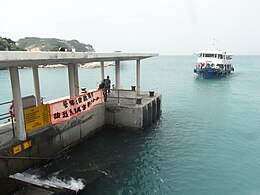Po Toi
| 蒲台島 | |
|---|---|

Tsui Wah Ferry vessel arriving at Po Toi public pier.
|
|
| Location of Po Toi Island within Hong Kong | |
| Geography | |
| Area | 3.69 km2 (1.42 sq mi) |
| Administration | |
| Po Toi | |||||||||
| Traditional Chinese | 蒲台島 | ||||||||
|---|---|---|---|---|---|---|---|---|---|
|
|||||||||
| Alternative Chinese name | |||||||||
| Traditional Chinese | 蒲苔島 | ||||||||
|
|||||||||
| Transcriptions | |
|---|---|
| Yue: Cantonese | |
| Yale Romanization | Pòuh tòih dóu |
| Jyutping | Pou4 toi4 dou2 |
| Transcriptions | |
|---|---|
| Yue: Cantonese | |
| Yale Romanization | Pòuh tòih dóu |
| Jyutping | Pou4 toi4 dou2 |
Po Toi (commonly Chinese: 蒲台島, originally Chinese: 蒲苔島) is the main island of the Po Toi Islands and the southernmost island of Hong Kong, with an area of 3.69 km².
It is said that the island used to produce dried seaweeds (苔), which were shaped like the cattail hassock (蒲團) used by the monks for sitting; therefore the island was originally called 蒲苔島, the present common name being a corruption. Another explanation states that Po Toi looks like a floating platform (浮台) when viewed from a distance on sea. 蒲 is another character meaning "to float" in the local dialect, thus giving the island its name.
The island had historically a maximum of about 1,000 fishermen and farmers, whose economic activity consisted mainly in fishing, farming and seaweed harvesting. The population lived mainly in two villages, Chang Shek Pai (長石排) and Shan Liu (山寮). The population decreased sharply over the past decades, with the younger generations moving to the city.
Po Toi is famous for its rock formations, such as the Buddha Hand Rock aka. Palm Cliff (佛手巖), the Coffin Rock (棺材石), the Tortoise Climbing up the Mountain (靈龜上山) and the Supine Monk (僧人石).
Ancient rock carvings on the island, believed to date back to the Bronze Age (around 1500-700 BC), were discovered in the 1960s. They have been listed as declared monuments of Hong Kong since 1979. These may be viewed on a spur-track on the track that runs between the main harbour (Tai Wan), and the lighthouse.
A Tin Hau Temple is located on Po Toi, facing the bay of Tai Wan (大灣). While its construction date is unknown, it is documented that the temple was renovated in 1893.
Mo's Old House, or the "Deserted Mansion of Family Mo" (巫氏廢宅), usually referred to as the "Haunted House", is a popular venue of "adventure" for the young visitors. The existing house was built in the 1930s at Chang Shek Pai and has fallen into ruins.
...
Wikipedia

